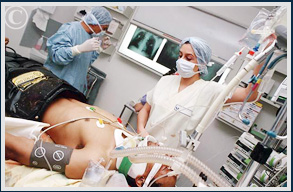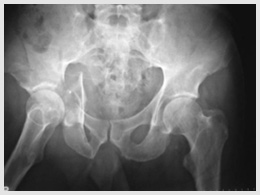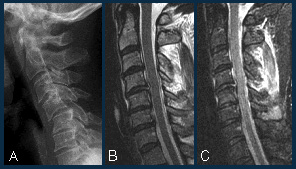Trauma refers to "a body wound or shock produced by sudden physical injury, as from violence or accident." It can also be described as "a physical wound or injury, such as a fracture or blow." Major trauma (defined by an Injury Severity Score of greater than 15) can result in secondary complications such as circulatory shock, respiratory failure and death. Resuscitation of a trauma patient often involves multiple management procedures. Trauma is the sixth leading cause of death worldwide, accounting for 10% of all mortality, and is a serious public health problem with significant social and economic costs.
Classification: Trauma can be classified by the affected area of the body (percentages of total incidence):
 Polytrauma (40%) Polytrauma (40%)- Head injury (30%)
- Chest trauma (20%)
- Abdominal trauma (10%)
- Extremity trauma (2%)
- Facial trauma
- Spinal cord injury
- Genitourinary system trauma
- Pelvic trauma
- Soft tissue injury
Trauma may also be classified by the affected demographic group (for example, trauma in the pregnant, pediatric, or geriatric patient). They may also be classified by the type of force applied to the body, such as blunt trauma versus penetrating trauma.
Causes and risk factors:
Blunt trauma is the leading cause of traumatic death in the United States. Most cases of blunt trauma are caused by motor vehicle accidents. Falls, a subset of blunt trauma, are the second most common cause of traumatic death. In most cases a fall of greater than three times the victim's height is defined as a severe fall. Penetrating trauma is caused when a foreign object such as a bullet or a knife enters a tissue of the body, creating an open wound. In the United States most deaths caused by penetrating trauma occur in urban areas and 80% of these deaths are caused by firearms. Blast injury is a complex cause of polytrauma. It commonly includes both blunt and penetrating trauma and may also be accompanied by a burn injury.
 By identifying risk factors present within a community and creating solutions to decrease the incidence of injury, trauma referral systems can help to enhance the overall health of its population. Ingestion of alcohol and illicit drugs are risk factors for trauma, particularly traffic collisions, violence and abuse. Long-acting benzodiazepines increase the risk of trauma in elderly people. By identifying risk factors present within a community and creating solutions to decrease the incidence of injury, trauma referral systems can help to enhance the overall health of its population. Ingestion of alcohol and illicit drugs are risk factors for trauma, particularly traffic collisions, violence and abuse. Long-acting benzodiazepines increase the risk of trauma in elderly people.
Diagnosis:
1) Physical examination-
The purpose of the primary survey is to identify life-threatening problems. Upon completion of the primary survey, the secondary survey is begun. This may occur during transport or upon arrival at the hospital. The secondary survey consists of a systematic assessment of the abdominal, pelvic and thoracic area, complete inspectionof the body surface to find all injuries, and a neurological examination. The purpose of the secondary survey is to identify all injuries so that they may be treated. A missed injury is one which is not found during the initial assessment (for example, as a patient is brought into a hospital's emergency department), but rather manifests itself at a later point in time.
2) Imaging -
 X-rays of the chest and pelvis are commonly performed in major trauma Focused assessment with sonography for trauma (FAST), can also be used. Computed tomography (CT) scans are the gold standard in imaging in major trauma. They however may only be performed in people with a relatively stable blood pressure, heart rate, and sufficient oxygenation. Full-body CT scans known as pan-scans improve survival in those who have suffered major trauma. The scans are done using intravenous radiocontrast but not oral contrast. There are concerns of radiation exposure and concerns regarding negative effects of contrast on the kidneys. However some centers routinely do CTs with contrast before verifying renal function even in the elderly and have not found negative side effects with respect to the kidneys. With modern imaging technology a complete scan can be performed in less than 10 minutes. In the emergency department in the United States CT or MRI imaging is done in 15% of people who present with injuries as of 2007 (up from 6% in 1998). In those who poor blood pressure or a fast heart rate from a presumed abdominal bleeding delaying surgery for abdominal CT imaging may worsen outcomes. X-rays of the chest and pelvis are commonly performed in major trauma Focused assessment with sonography for trauma (FAST), can also be used. Computed tomography (CT) scans are the gold standard in imaging in major trauma. They however may only be performed in people with a relatively stable blood pressure, heart rate, and sufficient oxygenation. Full-body CT scans known as pan-scans improve survival in those who have suffered major trauma. The scans are done using intravenous radiocontrast but not oral contrast. There are concerns of radiation exposure and concerns regarding negative effects of contrast on the kidneys. However some centers routinely do CTs with contrast before verifying renal function even in the elderly and have not found negative side effects with respect to the kidneys. With modern imaging technology a complete scan can be performed in less than 10 minutes. In the emergency department in the United States CT or MRI imaging is done in 15% of people who present with injuries as of 2007 (up from 6% in 1998). In those who poor blood pressure or a fast heart rate from a presumed abdominal bleeding delaying surgery for abdominal CT imaging may worsen outcomes.
3) Surgical techniques-
Surgical techniques, such as diagnostic peritoneal lavage, placement of a thoracostomy tube, or pericardiocentesis are often used in cases of severe blunt trauma to the chest or abdomen, especially in the setting of deteriorating hemodynamic stability. In those who are hypotensive due to presumed internal abdominal bleeding transfer to the operating room for a laporotomy is the preferred method of determining a definitive diagnosis. |
